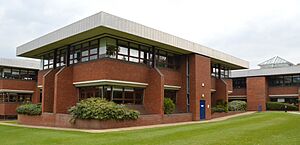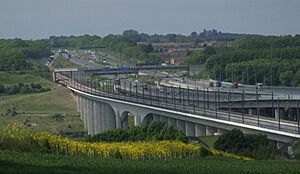Halcrow Group facts for kids
| Subsidiary | |
| Industry |
|
| Founded | 1868 |
| Founder | Thomas Meik |
| Headquarters | London, United Kingdom |
|
Number of locations
|
90 offices worldwide, of which 28 are in the UK |
|
Key people
|
|
| Revenue | £238 million (2011) |
|
Number of employees
|
3377 (2011) |
| Parent | CH2M Hill (acquired by Jacobs in 2017) |
Halcrow Group Limited was a big British company. They were experts in engineering and design. They helped plan and build large projects all over the world. These projects included roads, railways, water systems, and buildings. Halcrow worked in more than 70 countries. They had over 90 offices around the globe.
The company started in 1868. It was founded by Thomas Meik. Early on, they focused on projects for ships and trains. These projects were mainly across the UK. Later, William Halcrow led the company. He helped them get into new areas of engineering. This included building deep tunnels and dams for electricity.
Halcrow helped a lot during the Second World War. They built special floating harbours called Mulberry Harbours. These were used during the D-Day landings. They also gave advice on the famous bouncing bomb. After the war, Halcrow worked on many power projects. They built dams to create electricity for homes. They also designed tunnels for trains, like parts of the Channel Tunnel.
By the year 2000, most of Halcrow's work was still in the UK. But a lot of their business came from overseas projects too. In 2011, a US company called CH2M Hill bought Halcrow. The Halcrow name was eventually stopped in 2013. Then, in 2017, CH2M Hill was bought by another company, Jacobs Engineering Group.
Contents
Halcrow's History
How It Started
The company began in 1868. It was started by a civil engineer named Thomas Meik. At first, the company used his name. Later, it used the names of his sons, Patrick and Charles. They worked a lot on ports, shipping, and railway projects. These were in the North of England, Wales, and Scotland. In the 1890s, they started working on projects in other countries.
The 20th Century
In the first half of the 1900s, William Halcrow (who later became Sir William) guided the company. He helped them work on new types of engineering. This included building tunnels and projects that made electricity from water.
During the Second World War, Halcrow helped with many important tasks. They designed and oversaw the building of deep underground shelters. They also built military ports. A big project was the Mulberry Harbours. These were temporary harbours used during the D-Day landings. The company also advised on the bouncing bomb. They helped with ways to fix damage during air raids, known as The Blitz.
After the war, Halcrow worked on many projects in Scotland. They built new hydroelectric schemes. These schemes used water to create power for people. The Glen Affric scheme started in 1947. It was the largest of these projects. Other similar projects were in Glen Garry and Glen Moriston. Glen Moriston even had one of the first underground power stations in the UK.
In Wales, Halcrow's main work was on water supply projects. They built dams like the Claerwen dam (finished in 1952) and the Clywedog dam (finished in 1967). These dams created reservoirs. They helped control river levels and supplied drinking water to towns. Halcrow also designed railway tunnels. Examples include the Woodhead Tunnel (finished in 1954) and a tunnel at Potters Bar (finished in 1955). They also started work on the new Victoria line underground railway in London. Halcrow was also involved in the early designs for the Channel Tunnel.
The company also worked overseas during this time. They built roads, bridges, and harbours. These projects were in countries like Ghana, Libya, and Mozambique. Halcrow also worked on dams in Venezuela. They also built a power station in Buenos Aires.
The company changed its name several times in the 20th century. Some names included CS Meik and Buchanan (1920) and Sir William Halcrow and Partners (1944). Finally, it became Halcrow Group in 1998.
The 21st Century

By the year 2000, about 60% of Halcrow Group's business came from projects in the UK. The rest came from their work outside the UK. By this time, they offered many types of consulting. This included projects for water, transport, shipping, and property. Their clients included government groups and other companies.
In 2008, the company made £468 million. By then, almost half of their business was from outside the UK. Halcrow was owned by its employees and staff shareholders for a long time. It stayed an independent company until late 2011.
Becoming Part of CH2M
In September 2011, CH2M Hill announced they would buy Halcrow. On November 10, 2011, CH2M Hill officially bought Halcrow for £124 million.
Reports later showed that CH2M Hill basically saved Halcrow. Halcrow had lost a lot of money in its last year as an independent company. CH2M Hill's financial help was very important for Halcrow to keep going.
Joining Jacobs Engineering Group
On August 2, 2017, CH2M agreed to be bought by Jacobs Engineering Group. This deal was worth about US$2.85 billion. Shareholders approved the deal in December 2017. The purchase was completed on December 18, 2017.
Important Modern Projects
Halcrow worked on many big projects around the world. Here are some examples:
- Second Severn Crossing (UK; finished 1996) - Halcrow helped design this large bridge.
- Toronto Pearson International Airport (Toronto, Ontario, Canada; finished around 2006) - Halcrow Yolles was the main engineer for the passenger terminal.
- Clyde Arc Bridge (Glasgow, UK; finished 2006) - Halcrow designed this famous bridge over the River Clyde.
- One King Street West (Toronto, Ontario, Canada; finished 2007) - Halcrow provided engineering for this tall 51-story building.
- Sheikh Zayed Grand Mosque (finished 2007) - Halcrow supervised the building of this large mosque.
- Channel Tunnel Rail Link (High Speed 1) (UK; finished 2007) - Halcrow helped design and manage this £5.8 billion high-speed railway.
- Abu Dhabi International Airport (Abu Dhabi; finished 2008) - Halcrow planned and designed a second runway for this airport.
- Al Garhoud Bridge (Dubai; finished 2008)
- Yas Island Development (Abu Dhabi; finished 2009) - Halcrow was the main consultant for designing this large island development.
- Busan-Geoje Fixed Link (South Korea; finished 2010) - Halcrow advised on this big transport link project.
- Bond Street Station Upgrade (UK; detailed design 2010-12) - Halcrow was part of the team upgrading this London Underground station.
- Thames Hub (UK; concept 2011) - Halcrow gave technical advice for this big plan for the Thames Estuary.
- Tottenham Court Road tube station Upgrade (UK; finished 2017) - Halcrow was the lead designer for this London Underground station upgrade.
See also
- Hafren Power




